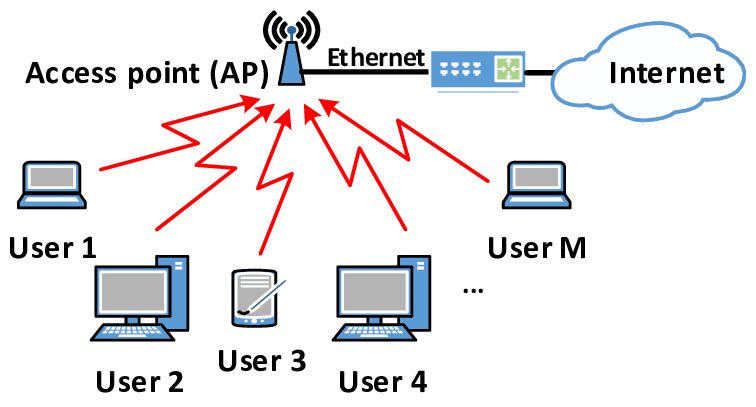Wireless LAN is made by connecting different devices through wireless communication to make a local area network. WLAN follows a standard named IEEE 802.11. WLAN connects laptops, smartphones, personal digital assistants, desktop computers, workstations and printers. This network is easy to install and use at the home or any other place.

WLAN include an access point (AP) which is used to connect to the internet. AP sends and receives radio frequency signal to the connected devices. In 1990 WLAN installation was expensive and was only deployed where the wired connection was not possible. In the late 1990s, cost decreases to implement WLAN because of using IEEE 802.11 standard. It works with a bandwidth of 2.4 GHZ (802.11b) or 5 GHZ (802.11 a). The devices which WLAN connects are also called clients.
WLAN gives a high data transfer rate. It uses star topology in which all nodes send/receive data through access points. It works better in homes and offices. Especially in offices no extra cables are required and arranging a meeting is also easy. It has a data transfer rate of 1-10 Mbps. Wireless LAN uses security which includes WEP or WPZ. It also uses infrared technology if required.
Advantages of wireless local area network (WLAN)
- It is a reliable type of communication
- As WLAN reduces physical wires so it is a flexible way of communication
- WLAN also reduces the cost of ownership
- It is easier to add or remove workstation
- It provides high data rate due to small area coverage
- You can also move workstation while maintaining the connectivity
- For propagation, the light of sight is not required
- The direction of connectivity can be anywhere i.e. you can connect devices in any direction unless it is in the range of access point
- Easy installation and you need don’t need extra cables for installation
- WLAN can be useful in disasters situation e.g. earthquake and fire. People can still communicate through the wireless network during a disaster
- It is economical because of the small area access
- If there are any building or trees then still wireless connection works
Disadvantages of wireless local area network (WLAN)
- WLAN requires license
- It has a limited area to cover
- Government agencies can limit the signals of WLAN if required. This can affect data transfer from connected devices to the internet
- If the number of connected devices increases then data transfer rate decreases
- WLAN uses radio frequency which can interfere with other devices which use radio frequency
- If there is rain or thunder then communication may interfere
- Attackers can get access to the transmitted data because wireless LAN has low data security
- Signals may be affected by the environment as compared to using fiber optics
- The radiation of WLAN can be harmful to the environment
- As WLAN uses access points and access points are expensive than wires and hubs
- Access points can get signals of nearest access points
- It is required to change the network card and access point when standard changes
- LAN cable is still required which acts as the backbone of the WLAN
- Low data transfer rate than wired connection because WLAN uses radio frequency
- Chances of errors are high
- Communication is not secure and can be accessed by unauthorized users
Example of WLAN
WLAN is used to make a limited network in school, home, campus, computer laboratory and office building.




